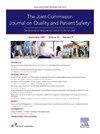Understanding Psychological Safety in Health Care: A Qualitative Investigation and Practical Guidance
IF 2.4
Q2 HEALTH CARE SCIENCES & SERVICES
Joint Commission journal on quality and patient safety
Pub Date : 2025-05-06
DOI:10.1016/j.jcjq.2025.04.009
引用次数: 0
Abstract
Background
Psychological safety is a critical teamwork competency that promotes effective communication, teamwork, patient safety, and the well-being of health care professionals. However, previous research on barriers and facilitators to promotion of psychological safety has focused mainly on clinical staff, omitting other health care disciplines that contribute to patient safety and high-quality care.
Methods
The authors conducted a qualitative study in one health system to identify barriers and facilitators to psychological safety in the workplace. Participants in a quality improvement (QI) initiative were invited through automated e-mails sent via the Qualtrics platform to participate in this survey. Employees self-selected whether to respond, as participation was not required as part of the QI initiative engagement.
Results
A total of 429 participants across 19 departments spanning administration, education, research, and clinical areas were invited. The average survey response rate across departments was 52.2%. Participants answered two open-ended questions: (1) “What are situations where it can be difficult to take an interpersonal risk and speak up [on this team]?” and (2) “What are the challenges to creating psychological safety within your current team?” Three psychological safety subject matter experts coded the data to extract factors and subthemes. Thematic factors at the individual, team, and organization level were uncovered. Sixteen subcategories of factors that affect psychological safety emerged, uncovering two implications.
Conclusion
Psychological safety as defined here includes not just team level but the individual and organization levels. Interventions must align with the factors at all three levels for a personalized and comprehensive approach.
了解卫生保健中的心理安全:质性调查与实践指导。
背景:心理安全是一种重要的团队合作能力,可以促进有效的沟通、团队合作、患者安全和卫生保健专业人员的福祉。然而,以往关于促进心理安全的障碍和促进因素的研究主要集中在临床工作人员身上,而忽略了有助于患者安全和高质量护理的其他卫生保健学科。方法:作者对某卫生系统进行定性研究,以确定工作场所心理安全的障碍和促进因素。通过Qualtrics平台发送的自动电子邮件邀请质量改进(QI)计划的参与者参与此调查。员工自行选择是否回应,因为参与并不需要作为QI倡议参与的一部分。结果:共邀请了来自行政、教育、研究和临床等19个部门的429名参与者。各部门的平均调查回复率为52.2%。参与者回答了两个开放式问题:(1)“在什么样的情况下,(在团队中)冒人际风险说出来是很困难的?”以及(2)“在你目前的团队中创造心理安全感的挑战是什么?”三名心理安全主题专家对数据进行编码,提取因子和子主题。揭示了个人、团队和组织层面的主题因素。影响心理安全的因素有16个子类别,揭示了两个含义。结论:心理安全不仅包括团队层面,还包括个人和组织层面。干预措施必须与所有三个层面的因素保持一致,以采取个性化和全面的办法。
本文章由计算机程序翻译,如有差异,请以英文原文为准。
求助全文
约1分钟内获得全文
求助全文
来源期刊

Joint Commission journal on quality and patient safety
HEALTH CARE SCIENCES & SERVICES-
CiteScore
3.80
自引率
4.30%
发文量
116
审稿时长
49 days
 求助内容:
求助内容: 应助结果提醒方式:
应助结果提醒方式:


